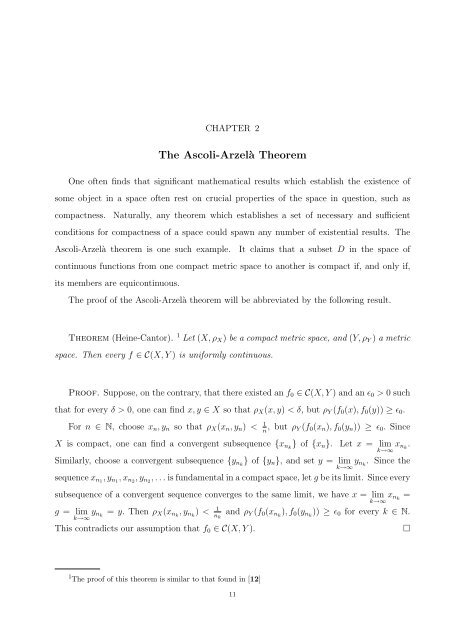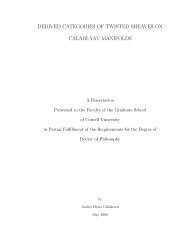FIVE MAJOR RESULTS IN ANALYSIS AND TOPOLOGY Aaron ...
FIVE MAJOR RESULTS IN ANALYSIS AND TOPOLOGY Aaron ...
FIVE MAJOR RESULTS IN ANALYSIS AND TOPOLOGY Aaron ...
You also want an ePaper? Increase the reach of your titles
YUMPU automatically turns print PDFs into web optimized ePapers that Google loves.
CHAPTER 2<br />
The Ascoli-Arzelà Theorem<br />
One often finds that significant mathematical results which establish the existence of<br />
some object in a space often rest on crucial properties of the space in question, such as<br />
compactness. Naturally, any theorem which establishes a set of necessary and sufficient<br />
conditions for compactness of a space could spawn any number of existential results. The<br />
Ascoli-Arzelà theorem is one such example. It claims that a subset D in the space of<br />
continuous functions from one compact metric space to another is compact if, and only if,<br />
its members are equicontinuous.<br />
The proof of the Ascoli-Arzelà theorem will be abbreviated by the following result.<br />
Theorem (Heine-Cantor). 1 Let (X,ρX) be a compact metric space, and (Y,ρY ) a metric<br />
space. Then every f ∈ C(X,Y ) is uniformly continuous.<br />
Proof. Suppose, on the contrary, that there existed an f0 ∈ C(X,Y ) and an ǫ0 > 0 such<br />
that for every δ > 0, one can find x,y ∈ X so that ρX(x,y) < δ, but ρY (f0(x),f0(y)) ≥ ǫ0.<br />
For n ∈ N, choose xn,yn so that ρX(xn,yn) < 1<br />
n , but ρY (f0(xn),f0(yn)) ≥ ǫ0. Since<br />
X is compact, one can find a convergent subsequence {xnk } of {xn}. Let x = lim xnk<br />
k→∞ .<br />
Similarly, choose a convergent subsequence {ynk } of {yn}, and set y = lim ynk . Since the<br />
k→∞<br />
sequence xn1,yn1,xn2,yn2,... is fundamental in a compact space, let g be its limit. Since every<br />
subsequence of a convergent sequence converges to the same limit, we have x = lim<br />
k→∞ xnk =<br />
g = lim<br />
k→∞ ynk<br />
= y. Then ρX(xnk ,ynk ) < 1<br />
nk and ρY (f0(xnk ),f0(ynk )) ≥ ǫ0 for every k ∈ N.<br />
This contradicts our assumption that f0 ∈ C(X,Y ). <br />
1 The proof of this theorem is similar to that found in [12]<br />
11
















